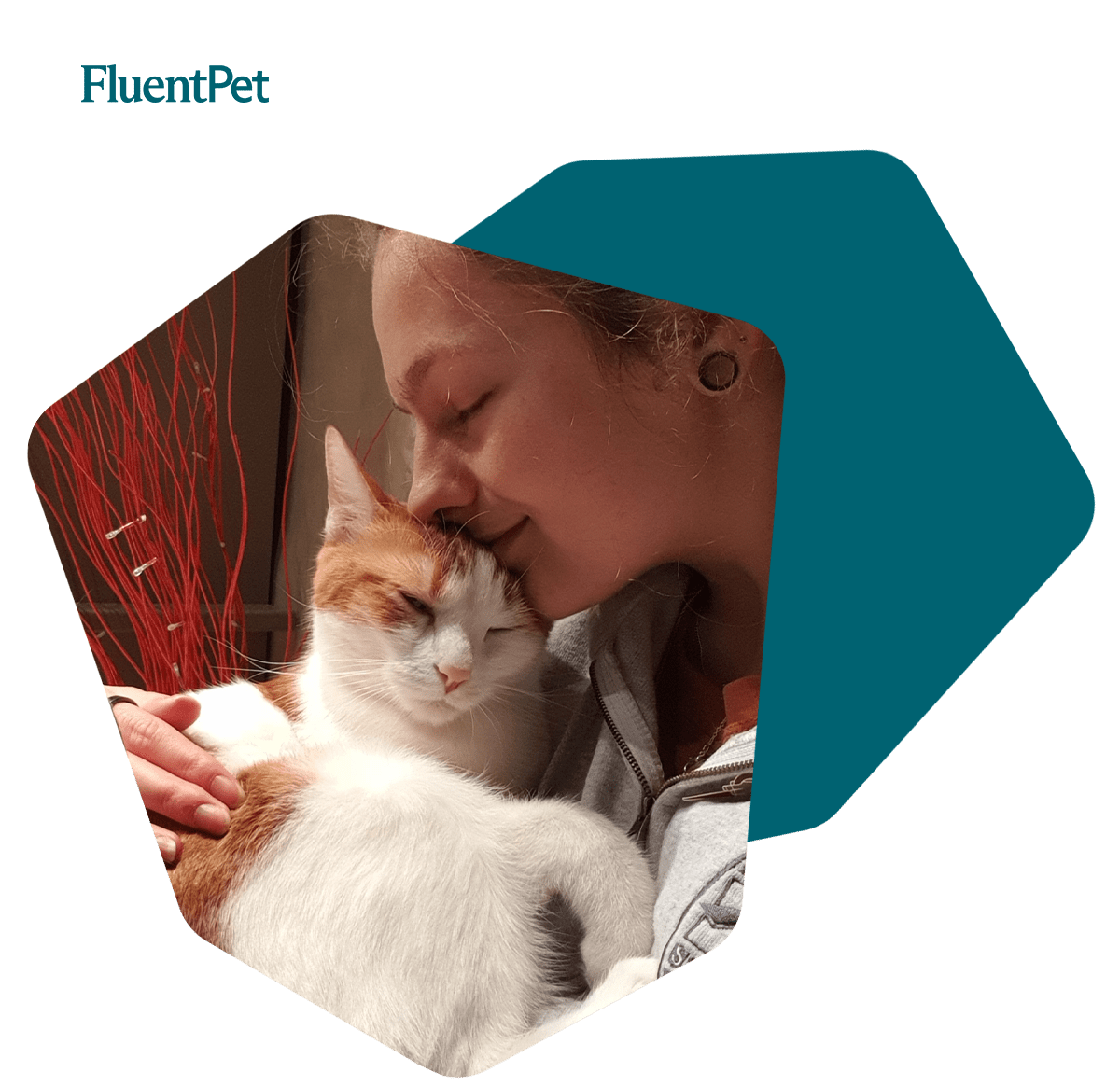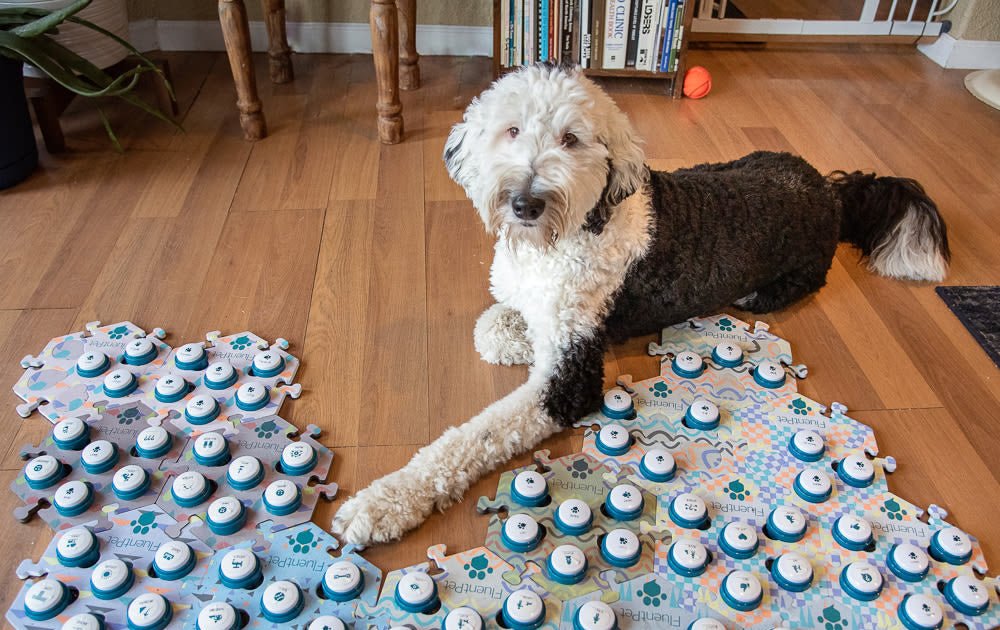
At a café in La Defense, Paris, a young woman in a powder-blue blazer waves at me from across the patio. When we sit, I spy a tattoo inked on her bare forearm: a sleeping cat curled into a ball. This inked kitty, of course, is Flint, Héloïse's orange and white tabby of five and a half years.
Héloïse, known as @flintcantalk on TikTok and Instagram, has raised Flint since kittenhood. Rescued at birth, Flint was brought to her parents' veterinary clinic. There, he joined dozens of other cats and dogs, so many that Héloïse tells me she can no longer keep track.
While the U.S. has seen button-using cats and dogs go viral again and again, Augmentative Interspecies Communication (AIC) devices remain a relatively new curiosity in France. Héloïse and Flint began to use buttons in March 2021, and Héloïse only knows a handful of French learners who are active on social media.
Choosing the Right Words for Your Cat
At the moment, Flint has 22 words, though he only regularly uses six or seven of them. His favorite buttons are outside, pets, play, and treat. With the exception of "Love you," all of Flint's buttons are recorded in French. I point out that this makes Flint bilingual––and that his French vocabulary is already more expansive than mine. Héloïse laughs and adds that there are grammatical tense considerations too when it comes to French button-teaching.
For example, "to go" in French is "aller" in its infinitive form, but it's "va" when conjugated. Héloïse uses both forms verbally with Flint: Flint veut aller dehors (Flint wants to go outside) versus Julien va dehors (Julien, Héloïse's boyfriend, goes outside).
Héloïse says, "When I want to put a new word on the board, I have to choose which form I want to record and use because they sound nothing alike." At this point, I am forced to concede that I will never be as linguistically advanced as this particular tabby and give up on taking notes on the impromptu French lesson.
How to Prepare Your Learner
Despite these unique challenges, Héloïse gives the same advice to anyone trying to teach their learner to use buttons. To prepare your learner to use buttons successfully, choose words or phrases most motivating to them. Use them out loud in appropriate contexts as often as possible. And if it helps, forgo proper grammar entirely. Remaining consistent in your word choice improves their comprehension.
Right now, soupe, or wet food, is Flint's most popular request. Héloïse added soupe after Flint spontaneously combined the words "water" and "treat" to request his wet food. Héloïse says she has never modeled or taught those words to represent wet food, and she thinks it's the most impressive phrase she's seen him use so far.
But how did she decipher the invented phrase "water treat"? She tells me she'd learned to recognize Flint's behavior. When he requested "water treat," he would scratch or pace before the wet food cabinet. Looking at your learner's body language and behavior alongside their presses can be a great way to confirm their communicative needs.
The Art of Teaching Cats to Talk with Buttons
I ask Héloïse if she's noticed any distinct challenges teaching a cat to use buttons. Héloïse replies she finds it harder to find motivating words for Flint besides the basics like outside, food, pets, and play.
"I would definitely say you need to be more patient and observe your cat. Most dogs are probably easier to read and have a wider panel of activities to start with. They may have a variety of words like potty, outside, dog park, car ride, walk, whereas not all cats even go outside, so the choice of easy words to understand and request seems reduced in the first place."
The Evolutionary History of Cats vs Dogs
Noticeable differences in communication and motivation between cats and dogs arise from their evolutionary history. Early domestication and cooperation between humans and wolves date back to over 35,000 years (1). Over time, wolves have naturally co-evolved alongside humans into the domestic dogs they are today. They have faithfully been our sentinels, hunters, and lifelong companions. These bonds solidified as wolves developed the ability to read and even form facial cues to better communicate with humans (2).
Unlike dogs, however, the ancestors of cats lived alone. Modern domestic cats originated around the Middle East, and scientists suspect cats began to coexist with humans during the era of agricultural advancement (3). They were brought onto ships and farms to catch and control pests such as mice, and they have not evolved significantly since.
While cats have grown more affectionate toward humans, evident by their increased meowing and human-directed vocalization, they have historically not needed our intervention. Cats were not bred to cooperate in the same manner as dogs were. Even so, felines have benefited greatly from this symbiotic relationship––they have domesticated us as much as we have them.
Today, this evolutionary history does appear to be relevant to feline button-pressing behavior. Because cats tend to be more self-sufficient, it can be more challenging for us to find the words they need, and that's not to mention that every cat also has their own personality, interests, and habits.
It may sound counterintuitive, but adding more words to a soundboard can help your learner progress with their current vocabulary. Héloïse offers another tip: "Your learner doesn't need to regularly use every word on their soundboard before adding a new one, although they do have to understand it. For example, Flint never uses my name or my boyfriend's name, but that's because he doesn't need to. He will get my attention no matter which button he presses."

How Old is Too Old for Talking Buttons?
As a member of the How.TheyCanTalk research community, Héloïse often receives questions about Flint regarding his age and species. How old is too old? Can an adult cat learn to communicate with buttons? Can cats learn to use buttons at all?
Héloïse answers in her easy manner: "Cats can, and age doesn't matter." She explains that transitioning to a soundboard may be easier for older learners as many of them already understand spoken words. Because Flint recognized the word "outside," learning his first button was not difficult. He knew “outside” corresponded with heading out the door.
But while Héloïse suspected that Flint knew what "outside" meant, she noticed that he still never used his button. He would scratch or paw at the door to communicate in his own way instead. Héloïse soon realized this was because Flint didn’t understand how to activate his button, an issue that was later remedied with a few rounds of target training.
Since cats are lighter-footed (pawed), it can be trickier to teach them how to apply the right amount of pressure to activate their buttons. One way to work on this problem is through target training. Héloïse recommends this video or this video for new teachers as a great place to get started with the basics.
Better Understanding Through Talking Buttons
Héloïse lights up when she talks about how buttons have changed her and Flint's life. It's made communicating less frustrating, and he's able to understand her better as well.
"I never knew he wanted to play so much. It's easy to guess if Flint wants a treat or to go outside, but it's much harder to know when he wants to play. Buttons have clarified a lot."
Héloïse says she can't imagine not having buttons in the future. If she adopts another cat, she fully plans to start them with buttons too.
It's curious how the simplest devices––a recordable button and speaker––can connect us so profoundly to those we love. With constantly evolving technology, bridging the communicative gap from culture to language has never been easier. Sitting in a café halfway around the world, I find that the same desires drive Héloïse and me despite our diverse backgrounds. And it's no complicated desire either. We just want to feel closer to the ones we love. While modern translation services and technology have globally lowered barriers between people, it is the soundboard that's lowered barriers between species. It's raised new questions about what both separates and tethers us to our animal friends and family.
As I admire the tattoo of Flint sleeping on Héloïse's forearm, I think how lucky she is to have a friend so near to her heart that they’ve created their own form of language together––so connected that her skin carries his impression, so close that his words are hers, too.

Written by Irene Y. Hou, recent UCSD Cognitive Science grad, who interviewed @flintcantalk in her last quarter abroad.
1. Thalmann, O., Shapiro, B., Cui, P., Schuenemann, V. J., Sawyer, S. K., Greenfield, D. L., Germonpré, M. B., Sablin, M. V., López-Giráldez, F., Domingo-Roura, X., Napierala, H., Uerpmann, H.-P., Loponte, D. M., Acosta, A. A., Giemsch, L., Schmitz, R. W., Worthington, B., Buikstra, J. E., Druzhkova, A., … Wayne, R. K. (2013). Complete mitochondrial genomes of ancient canids suggest a European origin of domestic dogs. Science, 342(6160), 871–874. https://doi.org/10.1126/science.1243650
2. Kaminski, J., Waller, B. M., Diogo, R., Hartstone-Rose, A., & Burrows, A. M. (2019). Evolution of facial muscle anatomy in dogs. Proceedings of the National Academy of Sciences, 116(29), 14677–14681. https://doi.org/10.1073/pnas.1820653116
3. Driscoll, C. A., Clutton-Brock, J., Kitchener, A. C., & O'Brien, S. J. (2009). The Taming of the cat. Genetic and archaeological findings hint that wildcats became housecats earlier--and in a different place--than previously thought. Scientific American, 300(6), 68–75.




Leave a comment
This site is protected by hCaptcha and the hCaptcha Privacy Policy and Terms of Service apply.